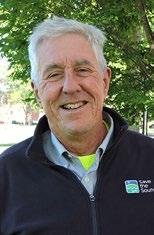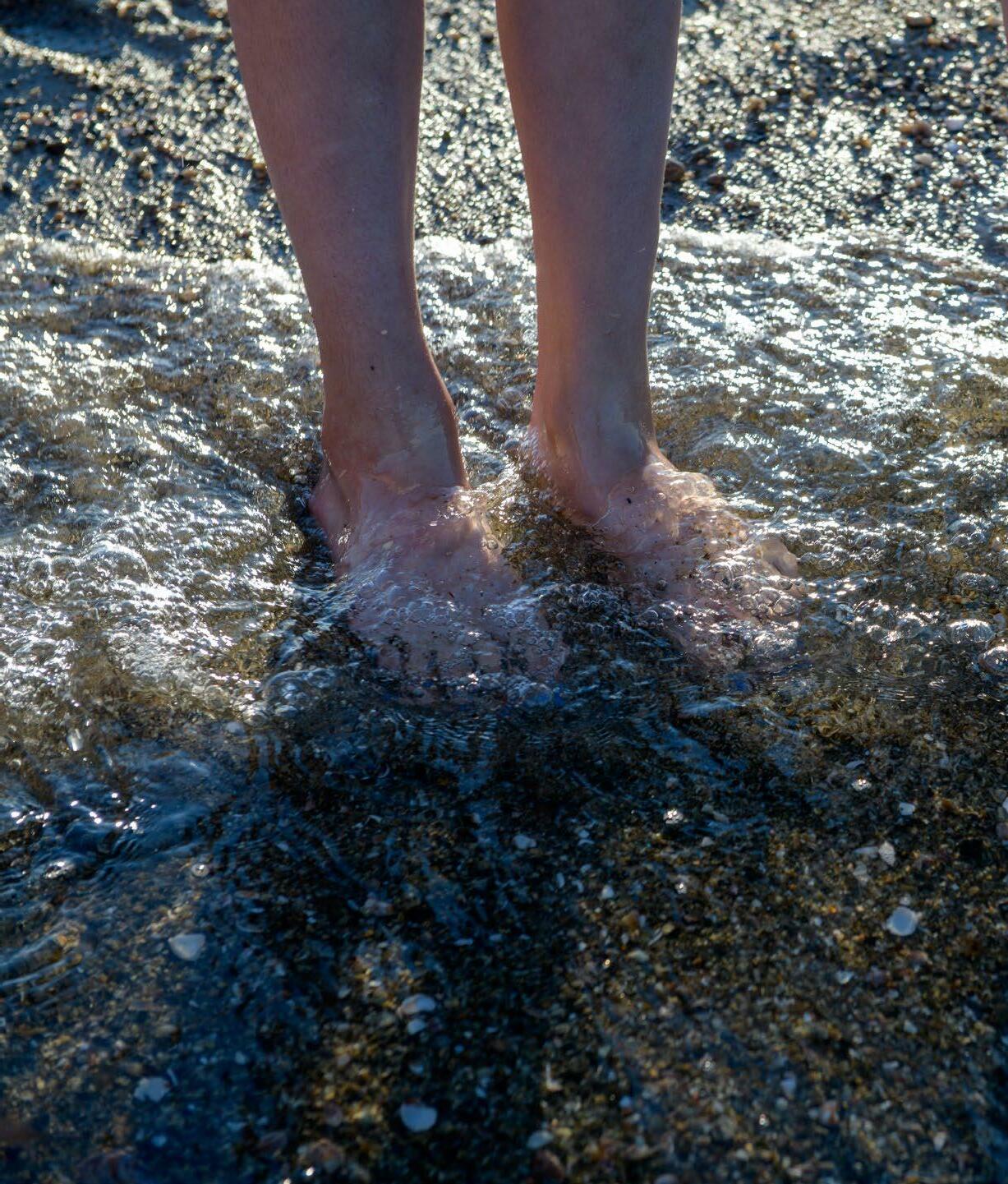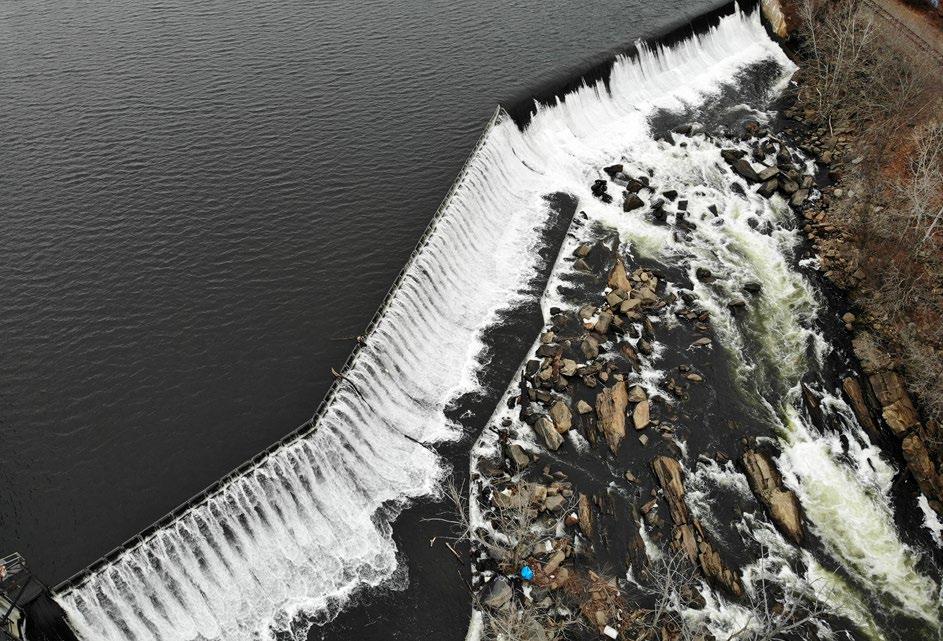Annual Report 2022



In 2022, Save the Sound is celebrating its 50th anniversary and looking to the future. As you may have heard, Curt Johnson is retiring in the fall of 2022. We are celebrating Curt’s tenure as Save the Sound’s president and thanking him for all of his dedication, energy, and accomplishments. At the same time, we feel fortunate to welcome Leah Lopez Schmalz as our new president to launch our 5-year Strategic Plan to protect, restore, and transform our Long Island Sound region through a framework that will maximize our impact.
A long-time environmental advocate, Leah’s focus on the intersection of climate change, resiliency, and health increased after Hurricane Katrina devastated her home state of Louisiana. She joined Save the Sound in 2001 as staff attorney and grew into our VP of Programs in 2018—as a brilliant strategic campaigner and much-loved manager. Her long history with the organization, along with her outstanding leadership qualities, extreme knowledge of Long Island Sound and its environment issues, and knowhow to take action, made her the perfect choice as Save the Sound’s president. She was unanimously chosen by the Board to be Curt’s successor and I have no doubt she will lead the organization toward major environmental victories for our future.
Leah teamed up with our entire Board and staff to craft the 2022-2027 Strategic Plan. She not only helped to create the bold and inspiring concepts in the plan but is personally invested in the plan’s vision for our organization. The plan builds on our strengths and promises to protect, restore, and transform our region’s environment.
Please join me in welcoming Leah Lopez Schmalz as Save the Sound’s new president!
With warm wishes,
Todd Cort Board Chair

This is my last letter as Save the Sound’s president. I welcome Leah Lopez Schmalz as the new leader of the organization. Thank you for all you made possible during my tenure as president; it has been my pleasure to work with you to take action for our region’s environment. We have accomplished many great things in my time here.

In the last five years, you transformed our water quality program from early stages to a mature program. You also expanded our legal work and advocacy, significantly diminishing sewage spills and nitrogen levels in Westchester and Connecticut. In 2017, the Long Island Soundkeeper was merged with Save the Sound and today we have three boats, two full time staff, and several seasonal staff monitoring our waters. That same year, we conducted the first Unified Water Study, a program that allows for water quality data to be compared all over the Sound. We currently have 26 partners monitoring the water in 44 bays and harbors!
Thanks to you, both New York and Connecticut made progress in setting ambitious clean renewable targets. Save the Sound is working to advance clean transportation, off-shore wind energy, and availability of energy efficiency measures and renewable sources for all who live in the region.
Your support fueled growth of our ecological restoration team into our region’s leader. We use nature-based solutions removing dams, creating rain gardens, and transforming landscapes with large scale projects. Special thanks to Libby and Rob Alexander who made possible the expansion of our New York team to include Katie Friedman, our New York Ecological Restoration Program Manager, who is transforming communities, rivers and coasts from Rye to Long Island.
Thanks to your advocacy, Plum Island—threatened with development—was taken off the auction block and may become a National Monument if our efforts are successful. Had we not had your support to lead the coalition of 117 organizations, none of this would have happened.
At an organizational level, I collaborated with Leah and board chair Todd Cort to establish a visionary and achievable 5-year strategic plan (2022-2027). The plan builds on our strengths and promises to protect, restore, and transform our region’s environment.
Thanks so much for embarking with me in what has been a fantastic journey.
Warmly,

 A special thank you from Curt Johnson and Todd Cort for those who had a great impact on the last five years.
Libby and Rob Alexander Jack Brewer Barbara O. David Peter DeBell Amy Denton Gordon Geballe The John and Daria Barry Foundation Tripp Killin and the Jeniam Foundation Mary Ellen Kranzlin Long Island Sound Funders Collaborative National Fish and Wildlife Foundation Mark Tedesco
A special thank you from Curt Johnson and Todd Cort for those who had a great impact on the last five years.
Libby and Rob Alexander Jack Brewer Barbara O. David Peter DeBell Amy Denton Gordon Geballe The John and Daria Barry Foundation Tripp Killin and the Jeniam Foundation Mary Ellen Kranzlin Long Island Sound Funders Collaborative National Fish and Wildlife Foundation Mark Tedesco
The mission of Save the Sound is to protect and improve the land, air, and water of Connecticut and New York communities in and around Long Island Sound. We use legal and scientific expertise and bring people together to achieve results that benefit our environment for current and future generations.
Our vision is of a Connecticut, New York, and Sound region where the vitality of nature will be protected for people and wildlife, now and for many decades to come. A region in which people from all walks of life can unite in transforming struggling habitats, polluted waters, endangered wildlife, and a threatened planet into resilient, healthy, vibrant,
In 2022, Save the Sound is celebrating 50 years of action for our environment. Here are some of our major accomplishments, decade by decade. And here’s to the next 50 years!
Save the Sound is founded in 1972, Connecticut Fund for the Environment in 1978, and Long Island Soundkeeper in 1987. By 2017, all three organizations were merged. In 2020, we transitioned to the Save the Sound name under a single logo.

Printed on recycled paper.
’ 80sProtected unique bird habitat at Milford Point, now part of the National Wildlife Refugee system and home to the CT Audubon Society Coastal Center.
In a win for public health and the climate, an allience led by Save the Sound secured passage of Clean Cars standards, encouraging Connecticut to move from polluting fossil fuels to cleaner, renewable fuels.

Our water quality program was launched. Today we track bacteria levels all around the Sound, indicating fishable, swimmable, and livable waters and identifying water pollution.

Reopened 80 miles of river and 509 lake acres to migrating fish and restored 347 acres of riverbank, marsh, and dune.

’ 10sOur Board 2021-2022 Current Officers Todd Cort Chair Johan C. Varekamp, Ph.D. Vice-Chair Chip Angle Treasurer Joseph A. MacDougald Secretary Members Dina Brewster Barbara O. David Raphe Elkind E. Donald Elliott Justin Farmer Celia Felsher Evan Heller Dawn Henry Kiki Kennedy, M.D. Mary Ellen Kranzlin Leslie S. Lee Joseph A. MacDougald Claudia Mezey Bruni Pizarro Elizabeth Barry Swanson
Our team’s vision is of Connecticut and New York communities where the vitality of nature will be protected for people and wildlife for many decades to come. A Long Island Sound region in which people from all walks of life can unite in transforming struggling habitats, polluted waters, and a threatened planet into healthy, resilient, and inspiring places that sustain us.
Our new 5-year strategic plan builds on the successes of Save the Sound’s last 50 years, and charts a path to protect, restore, and transform the ecosystems and communities we all call home.
12,500 acres of endangered lands for people and wildlife
15 bays & harbors from raw sewage by expanding our “data to action” monitoring & fixing program
2 states by deploying an expanded Soundkeeper team to bust polluters
6 river systems by reviving historic fish runs and renewing ecological functions, while making communities safer and more resilient
1,000+ miles of unhealthy rivers that feed the Sound polluted stormwater
12 shorelines with the nature-based solutions that wildlife and neighborhoods need
4,500 Megawatts of energy to clean and renewable sources
8,000 fossil fuel cars, buses, and trucks to clean electric transportation for people of all income levels
160 city blocks with rain gardens to absorb pollution and flood waters
15 new relationships to support capacity building at BIPOC-led partner organizations
10,000 people’s engagement and commitment to Save the Sound
Over the last 50 years, Save the Sound has become a catalyst for change throughout the region. As we look to our next chapter as your Long Island Sound champion, we will build on our well-established approach of uniting science-driven advocacy, legal expertise, on-the-ground construction, and grassroots action to protect the Sound’s bays and harbors, restore the rivers that feed it, and transform our neighborhoods. We will inspire and engage people of many backgrounds united in the same cause: to save the Sound.
We know this future is possible because we have a proven track record of building community to find and fix environmental threats in your backyard. Whether it’s partnering with one homeowner to stop pollution with a single rain garden or taking on Shell Oil to protect our climate and Long Island Sound, we are in it for the long haul—every single day. And we are so glad to have you right here alongside us.
You protect our waters
Keeping our waters safe means measuring and making critical data available for you and everyone interested in our region. It also means taking action where needed to keep our communities healthy. You have accomplished a great deal in 2022:
You’ve increased the range of tests we can perform for the Unified Water Study (UWS), an important part of our water quality program that compiles data from 26 partners in 44 embayments all over the Sound. The John and Daria Barry Foundation Water Quality Laboratory in Larchmont, NY has made this work more effective.
The Unified Water Study is very important to the volunteers of the Ash Creek Conservation Association monitoring group. We live near the shore and enjoy its recreational and aesthetic value. The data we collect is used to drive water quality improvements in our harbor.” — Rick Landau, Ash Creek Conservation Association
You are driving action through water quality testing data. Our latest Beach Grades for more than 200 Long Island Sound beaches were released this summer on our website SoundHealthExplorer.org giving a clear picture of how your favorite beaches compare to others. The Sound Health Explorer displays seasonal rain totals, individual Beach Grades, and much more dating back to 2003. Our team, researchers, local government, elected officials, and residents like you use this data to ensure that pollution issues are addressed near beaches and bays.
Your support helps us to address sewage spills. Poorly maintained sewage systems can fall into a state of disrepair that may result in chronic sewage spills, impacting the health of residents and our shared environment. Our investigation of the pipe segment that failed in July, 2020 and poured 2.1 million gallons of raw sewage into the Mill River in New Haven lead to us file a Clean Water Act citizen suit enforcement action to ensure that this type of sewage spill is prevented in the future. In May, Save the Sound reached a collaborative agreement with the Greater New Haven Water Pollution Control Authority (GNHWPCA) that will yield a green infrastructure project at the Eli Whitney Museum in Hamden to reduce stormwater runoff and help ensure local residents can enjoy a clean Long Island Sound.

With you, our legal and community mobilization teams are protecting important endangered land all around our region. The endeavor to protect Oswegatchie Hills, in East Lyme, CT, has surpassed 20 years and, so far, no development has been authorized in the 236 acres of coastal forest. This parcel, the last mile of undeveloped land along the Niantic River, has been
at risk of losing one-third of its forest for an 840-unit condominium development, which would ruin sensitive wildlife habitats and threaten water quality. Save the Sound is leading the legal effort to prevent ruinous development and will not give up until the Hills are permanently protected.

In New York, Save the Sound’s leadership to protect Plum Island continues. The


island is home to incredible biodiversity, including 220 bird species—nearly one out of four bird species found in North America—and at least 111 plant and animal species of conservation concern. The Preserve Plum Island Coalition is working with the NY and CT senators, campaigning for the president of the United States to proclaim Plum Island a National Monument.
One acre of trees produces enough oxygen for 18 people to breath for a year and consumes the equivalent carbon dioxide of a car driving 26,000 miles per year.



 Source: The Nature Conservancy
In April, the results of a 2021 scientific dive off the coast of Plum Island, NY were released, documenting 126 species of plants and animals beneath the surface of Long Island Sound. The report was prepared by the New York Natural Heritage Program (NYNHP) and InnerSpace Scientific Diving and sponsored by generous donors and supported by staff of Save the Sound.
Source: The Nature Conservancy
In April, the results of a 2021 scientific dive off the coast of Plum Island, NY were released, documenting 126 species of plants and animals beneath the surface of Long Island Sound. The report was prepared by the New York Natural Heritage Program (NYNHP) and InnerSpace Scientific Diving and sponsored by generous donors and supported by staff of Save the Sound.
Removing dams is an effective way to restore rivers and bring back migratory fish. Human-built dams pose flood risks, impact ecosystems, contribute to the warming of rivers, and impede the passage of migratory fish that are key components of the Long Island Sound food chain. There are over 4,000 dams in Connecticut and 250 in Westchester County, NY alone, most of which no longer serve a useful purpose.


“We have to find a way for fish to migrate past this obstruction on the Naugatuck River so that we can finally realize all of the benefits of the public investments made by Connecticut taxpayers, our partner river towns, and the many activists in restoring the Naugatuck River over the past decades.”
KinneytowndamattheNagatuck River.
Photo:A.Budris/NVCOG.
Our lawyers, scientists, and engineers have embarked on an effort to free the fish on the Naugatuck River at Kinneytown Dam in Seymour, CT. The dam stands as the sole remaining barrier to the restoration of access to many miles of spawning and rearing habitat on the river and its tributaries. Removing the dam will allow several species of diadromous fish like American Shad, Alewife, Blueback Herring, and Sea Lamprey free passage deep into the heart of central Connecticut from the Housatonic estuary where it meets Long Island Sound. We’ve been working with local municipalities and environmental partners to make this vision of a restored Naugatuck River a reality—to return important fish populations to this major river.
Restoring rivers Creating living shorelines Ensuring clean water in bays and harborsMayor Neil O’Leary of Waterbury

Many coastal communities in New York and Connecticut have stabilized their shorelines with bulkheads and concrete seawalls. However, this disruption in the connectivity of land and sea fuels the loss of critical beach, dune, and marsh habitat—and threaten safety, as hardened coastlines can shunt water to nearby communities and fail to protectinfrastructure from flooding during severe storms.
With your support, we are working to implement living shorelines, a coastal stabilization technique that uses natural materials like native salt marsh plants and hybrid alternatives to traditional hardened structures. This coastal management practice can restore, enhance, and maintain shoreline and marsh habitat, while dissipating wave energy and mitigating flooding.
A good example of this important work is at Udalls Cove of Little Neck Bay in Queens, NY. In the first phase of this restoration project, we will install oyster castles and plant native coastal species to reestablish one acre of native salt marsh and oyster habitat while creating the conditions for marsh migration in an urban environment. This will address erosion, historical fill, and poor water quality in Udalls Cove, and improve coastal resiliency.
Capturing carbon: One square mile of salt marsh stores the carbon equivalent of 76,000 gallons of gas annually.
Source: NOAA.
Thanks to you, our Soundkeeper program is expanding! We now have our Soundkeeper Bill Lucey, a new fulltime associate Soundkeeper, seasonal staff, and three boats monitoring from Plum Island to the Throgs Neck. They are your eyes and ears in the Sound, monitoring all over the region, tracking down pollution, and mapping potential sewage sources to restore our Sound and bring life back to our waters.

When rain lands on impervious surfaces such as sidewalks, roads, roofs, and parking lots, it picks up pollutants including oil, antifreeze, heavy metals, pesticides, and bacteria, transporting them to lakes, streams, and rivers. They end up in Long Island Sound, harming marine life and closing beaches and shellfish beds.
For clean water and a healthy regional environment, our towns and cities need to create more natural buffers, allowing rainwater to soak into the soil, where it’s filtered for our waterways and can replenish groundwater.
The federal Clean Water Act requires municipalities to have a stormwater permit
to stop this type of pollution. But, many municipalities across Connecticut are not following the permit and are discharging stormwater pollution into our local waterways, violating federal water quality standards.
Our legal team helped to create state regulations and is working to ensure that Connecticut towns protect water quality by creating systems that reduce polluted stormwater discharges, using rain gardens, bioswales and other green infrastructure to absorb and filter, naturally. Many municipalities are required to disconnect one percent of impervious surfaces per year to reduce their polluted stormwater discharges. Most commonly,
“disconnection” means creating green infrastructure like rain gardens or bioswales to absorb and filter the water.

This year we filed Clean Water Act Enforcement Actions against Middletown, Redding, Ridgefield, and Burlington for failing to meet key obligations. We are also in ongoing discussions with other municipalities as the records have revealed that there is widespread non-compliance across the state. We will continue these efforts to bring other towns into compliance to ensure clean water statewide.
Below: The parking lot at Sunken Meadows Park, Long Island, NY was retrofited by Save the Sound to absorb stormwater. Photo: Rebecca Grella.

On the next page: Dave CruzBustamante is an Youth Eco Advocacy Corps member, selfidentified queer, working-class organizer, and high school junior from New Haven, CT. Photo: Greater New Haven Arts Council.
Save the Sound is working across the region to address stormwater pollution to transform our impervious cities with green infrastructure from small rain gardens to large landscapes to make them act like sponges and absorb and filter stormwater.
Fighting climate change Creating resilience Requiring accountabilityEmpowering the generations of tomorrow to address environmental issues is paramount to the resilience of our region. At Save the Sound, we engage youth, from water monitoring to advocacy, transforming a generation.
In Mount Vernon, a lowerincome, majority-Black town in Westchester County, we have partnered with the local Boys & Girls Club since 2019 to teach teens there how to find and stop water pollution
through education, advocacy, and water monitoring.

Meanwhile, the Youth Eco Advocacy Corps is an ongoing networking opportunity, where young environmental leaders share their sustainability initiatives and learn about climate policy. In partnering with young people on advocacy and environmental protection, we are melding our energies and expertise to increase civic participation.
Save the Sound is working to reconnect rivers, address flood risks and allow fish to flow freely with our partners, the Housatonic Valley Association (HVA) and the Naugatuck Valley Council of Governments (NVCOG) by looking at road-stream crossings—like culverts and bridges—in Connecticut. Alex Krofta, our Ecological Restoration Project Manager, says that “By doing these assessments of bridges and culverts, we can help towns plan for healthier ecosystems and safer roads.”
project links short- and long-term infrastructure planning with preserving the ecological functions of our watercourses. The information gathered from these studies will empower municipal decision-makers to allocate resources in a way that best serves the community and environment.”
The current rise in greenhouse gases (GHG) is unlike anything the planet has experienced since life began. The Northeast is the fastest warming region in the contiguous United States, with Connecticut and New York falling behind in their efforts to meet climate targets that, we now know, are too low.


To target our actions effectively and inspire others, we created the Climate Action Plan for Connecticut 2022 in collaboration with the Yale Center on Climate Change and Health. This Plan provides a short list of critical policies that the legislature should pass to ensure the state meets its Greenhouse Gas reduction targets in an equitable way. It also evaluates best practices for climate mitigation and Connecticut’s progress toward implementing them. To read the complete plan, please scan the QR code.
Due to global warming, spring begins a week earlier than it did a few decades ago. In many areas of New York, the first leaf date is more than 8 days earlier and the first bloom date is more than 4 days earlier than in the 1950s.
Source: NYS DEC
“This
— Rick Dunne, NVCOG Executive Director
Below are listed all donors that gave $1000 and above or in-kind donations during our 2021 Fiscal Year (October 1, 2020September 30, 2021)
Anonymous
Mr. Paul Ahern
Mr. and Mrs. Robert Alexander/ Robert L. and Elizabeth C. Alexander Fund
Lucy Ambach/The Chatto Fund American Endowment Foundation Avalon Park and Preserve Benjamin Baker/ Lockhart Vaughan Foundation Bank of America Charitable Gift Fund
John and Daria Barry Foundation Bessemer Giving Fund Boston Foundation Jack Brewer/Brewer Family Foundation
Bunting Family Foundation
C. Richard and Olive J. Brose Hie Hill Foundation
John L. Cecil and Celia A. Felsher
Louis and Virginia Clemente Foundation, in memory of Harry A. LeBien Common Sense Fund
Community Foundation for Greater New Haven Community Foundation of Eastern Connecticut Barbara O. David
Peter DeBell
Amy and Jim Denton Raphe Elkind E. Donald and Dr. Gail Charnley Elliott Environmental Defense Fund Fidelity Charitable Mr. and Mrs. P. Wesley Foster/ The Betty and Wes Foster Family Foundation
Friends of Oswegatchie Hills Nature Preserve
Gordon and Shelley Geballe/ Sassafras Foundation Geoffrey C. Hughes Foundation
Goldman Sachs Philanthropy Fund
Golub Family Fund
Mabel Burchard Fischer Grant Foundation
The Hayes Foundation James & Dawn Henry Kim and Flip Huffard/ Huffard Family Fund
J.P. Morgan Chase Charitable Giving Fund
The Jeniam Foundation Jewish Communal Fund John and Daria Barry Foundation
The John Merck Fund Joseph & Lisa MacDougald Fund
Kelley Memorial Fund
Mr. Chester W. Kitchings, Jr./ Kitchings Family Foundation Mary Ellen Kranzlin Michael S. and Carolyn W. Levine
Steven and Fern Loeb/ The Tebil Foundation
Long Island Sound Funders Collaborative
Long Island Sound Office, EPA Henry D. Lord
M.L.E. Foundation
David and Katherine Moore Family Foundation
Lori and Timon Malloy/ Sun Hill Foundation
Richard and Nancy Matthies
Douglas and Marie McKeige/ McKeige Charitable Trust
Josie Merck/Josephine A. Merck
Donor Advised Fund
Thomas and Sophie Murphy
National Fish and Wildlife Foundation
Melissa Newman Newman's Own Foundation Emily B. Nissley
The Fred I. and Gilda Nobel Foundation, Inc.
The Osprey Fund Overhills Foundation
Lynn Prowitt and Cole Prowitt-Smith/ Reenie Brown and Roy Makowsky Foundation, Inc.
Ms. Jean Richards/ Jean M. Richards Revocable Living Trust Rose Foundation Sandpiper Fund Sasco Foundation Robert F. Schumann Foundation Schwab Charitable Barbara and Peter Setlow The Skye Foundation
John and Nancy Sommi State of Connecticut Super Law Group LLC Susan Surova and Edward Janusz
SwedeHeart Family Fund Tortuga Foundation Town of Darien U.S. Fish and Wildlife Service Vanguard Charitable G. Unger Vetlesen Foundation Vranos Family Foundation
Anonymous
Emily Aber and Robert Wechsler
The late Mr. Jack Alexander/ Alexander Family Foundation Mr. Moses Alexander
Mr. and Mrs. Richard B. Alexander/ The Ballard Foundation Richard Amerling and Mary Kelly Mr. and Mrs. Chip Angle/ Angle Family Fund
Ayco Charitable Foundation Foster Bam
Roberta Barbieri
Barrett Outdoor Communications Robert J. Bauer Family Foundation Mr. William Baxter, III Robert I. Bayer/Jesse Bayer Foundation Charitable Trust Benevity Community Impact Fund Mr. and Mrs. Stephen Benjamin/ Helen & Stephen Benjamin Gift Fund
Mr. and Mrs. Mark W. Blackman/ Mark and Deborah Blackman Charitable Trust
Mr. and Mrs. Roy Bostock/ Bostock Family Charitable Fund
Ms. Kelly Brewer
Howard Benjamin Bullard
The Capital Markets Company Ruth O. Carroll
Robert and Ethel Churchill Karen Clute
Community Foundation of Greater Memphis
Ann E. Condon Fund
Peter and Diana Cooper Todd Cort and Jenn Rosenberg Diane A. Creedon
Vic Dasaro and Ellen Friedman David and Diane DeBell Family Fund
Michael Dunn and Deborah Moshier-Dunn
Cheryl and Daniel Dunson
Mr. and Mrs. Andrew J. Elliott/ R & M Foundation
Mr. and Mrs. Frederic Elliott/ R & M Foundation
Environmental League of Massachusetts
Aline and Henry Euler
R. Bradford Evans
Janet Fall
Patricia Farren and Jeffrey Myers/Round River Foundation Wendy Fish
Judith Fisher/Fisher Family Fund
Robert and Janet Fiske
Mrs. Elinor A. Fredston
Mr. and Mrs. Alfred Fressola/ Arthur and Elinor Fredston Fund
Mr. and Mrs. John Fullerton/ The Fullerton Family Foundation
Mr. Herbert Gardner/ Gardner Family Foundation
Philip and Marcia Giudice/ Giudice Family Fund
Mr. and Mrs. Bradley L. Goldberg/ Bradley L. Goldberg Family Foundation
Mr. and Mrs. Matthew Gorin/ Gorin Family Charitable Fund
Mrs. Emily Grant
Jason Grippo
Mr. and Mrs. Madison Grose/ The Grose Family Charitable Fund
Randall and Mary Hack/ Randall and Mary Hack Foundation Hampshire Foundation
Hildegarde Hannum
HMTX Industries LLC
Mr. and Mrs. Thomas Holloway Mr. William C. Horne
Mr. George Host/ Alexander Host Foundation
Anne H. Isbister
David and Amy Jaffe
Michael Kaminsky
Kaplan Family Foundation
Dr. and Mrs. Frederick Kaskel
Jim P. Kempner
Dr. Katherine Kennedy and The Honorable Ted Kennedy, Jr./ The Kiki and Ted Kennedy, Jr. Fund
Margaret Kilgore
Pamela P. Kindler
Mr. and Mrs. Jason Klein/ Ruth and Seymour Klein Foundation
David W. Knapp James B. Konopka and Susan M. Watanabe Mr. Rubén Kraiem Fred Krupp and Laurie Devitt Frank and Elisabet Landrey Ms. Marta Jo Lawrence Leslie S. Lee
Oskar and Olivia Lewnowski Jim and Vicky Linville/ Linville Family Foundation Philip and Christine Lodewick George A. & Grace Long Foundation
Robert Lorenz
LPL Financial Mark H. Lynch Mr. and Mrs. Peter L. Malkin Ellen and Terry Martin Thomas and Christine McGrath Betty McManus Mr. Daniel Mathison and Mrs. Helene Mathison/ The Lena and Dan Mathisson Fund
Stephen and Evalyn Milman Garrett and Mary Moran/ Garrett Moran and Mary Penniman Moran Family Foundation
Ryan Moran
Morgan Stanley Gift Fund Robert and Susan Morris/ Old Stones Foundation National Philanthropic Trust Irwin and Dorothy Nessel Foundation
Neuberger Berman New Canaan Community Foundation
New England Interstate Water Pollution Control Commission
The New York Community Trust NewAlliance Foundation
Amanda Oberg and Aaron Sack/ The Oberg Sack Family Fund
Katie O'Brien
O'Donnell Iselin Foundation Laurie Olinder
Patrick and Andrea O'Meara Dana and Carol Oviatt Gerson Pakula/Pakula Foundation Pamela and Richard Rubinstein Foundation
Frank Pannenborg
Edward Pawlak and Jane Roth
Penwood Realty Advisers, Inc. Regional Water Authority The Frances and Peter Robotti Foundation
Rocky Mountain Institute Harold Rose
Karen Royce, in honor of Leslie S. Lee Ruscito and Head Family Foundation
Peter Russell
Ruth & Seymour Klein Foundation Thomas Sargent and Allison Ijams/Thomas Sargent and Allison Ijams Charitable Foundation Save the River-Save the Hills Dave Schleinkofer, in memory of David Kohl Eric Schwartz
Leonard Schwartz
Security Traders Association of Connecticut Amy Shapiro Scholarship Fund Harry Sharlach
James and Margie Shaughnessy/ The Shaughnessy Family Charitable Fund
Anne and Alan Shaw Anna and George Shaw Dr. Ramsey David Shehadeh/ The Gennetian-Shehadeh Family Foundation
Shoreline Unitarian Universalist Society
Timothy and Tamsin Sickinger Mr. and Mrs. George Smith, III/ Smith Family Charitable Fund
Joanna and Ian Smith/ Joanna Oltman Smith and Ian Lynch Smith Fund Mario Smith and Barbara Heffernan Robert Smith, in memory of Melissa J. Schlag
Teagan Smith/ Aram Rae Family Fund Kurt Soderlund and Clea Newman Cleo and Jonathan Sonneborn/ The Jonathan and Cleo Sonneborn Advisory Fund Tad Sperry and Ellen Harvey Subaru of New England, Inc. Scott Thompson/ Thompson Family Giving Fund TIAA
Steve Tomlinson Town of Fairfield Harold and Susan Trischman Mac and Patricia Turner Kurt and Lisa Uihlein Johan Varekamp and Ellen Thomas Chris and Terri Walker Walters and Mason Retail, Inc. Chan and Leslie Wheeler Serena H. Whitridge
Tony and Jen Whitworth Wiener Family Philanthropy Steve Wiggins/ The Wiggins Foundation The Winston Foundation Peter Witkin/ Witkin Family Fund Andrew Wood
Mr. Paul Ahern Algae Art Mike Bady Bar Rated Entertainment LLC Barrett Outdoor Communications Bikram Yoga Rye Brook Boatmax Stephen Borghardt Bridgeport Islanders Captain’s Cove Seaport Cornell Cooperative Extension Marine Program
Ed Gathman Thomas Glacock Bob Haase Haddad & Partners Thomas Halaczinsky Mr. and Mrs. James Henry JK Kayak & SUP KA Davignon, Architect Klein Law Group of New York PLLC Lindsey's Craft Studio
Steve and Sarah Malinowski/ Fishers Island Oyster Farm Sheila Meehan
Daniel Wenzel Mendes
Ilene Merenstein Minneford Marina Pierce Rafferty/ Henry L. Ferguson Museum Safe Harbor, Greenport Tom Sargent/ Fishers Island Conservancy Savannah Bee Company Scoot & Paddle
Shore Thing Rentals
Southport Engineering Associates Nancy and Eric Vincent WindCheck
It is only through the generosity of our supporters that Save the Sound is able to work to achieve its mission. We are grateful to each and every donor to Save the Sound, at every gift level. You take action for our climate, heal our rivers and coastlines, save our endangered land, empower local communities and ensure a healthy Long Island Sound. Below are just a few examples of funders who are dedicated to advancing environmental protection in our region.

For over two decades The Fred I. and Gilda Nobel Foundation has supported the work at Save the Sound. The foundation was pivotal in the expansion of our Soundkeeper program by enabling Save the Sound to add another research and patrol boat into our fleet. The mission of The Fred I. and Gilda Nobel Foundation is to protect the Earth from environmental degradation and to assist marginalized people and communities in their struggles for economic, social, and environmental justice.
“Save the Sound has been very effective in its mission to improve our environment” — Barry Nobel

Ben has been on the front lines of impacting how we mitigate climate change, owning and operating companies that put solar power in front of communities of people to promote renewable energy. And for the last five years, he’s served on Save the Sound’s Climate Task Force, helping to make our climate program as effective as possible and also helps by raising funds to ensure that our climate fight remains strong.
The Rose Foundation for Communities and the Environment envisions a future where nature is protected, people’s rights are ensured, and environmental justice is advanced. The Foundation supports grassroots initiatives that help people exercise their rights as members of the community, citizens of the planet, and consumers whose collective purchasing power fuels our entire economy. The Rose Foundation is proud to support Save the Sound’s legal efforts to ensure that municipalities comply with Clean Water Act and other environmental laws though the Foundation’s long-term initiative to achieve justice for communities and the environment by channeling funds from legal settlements directly back into impacted communities. Over the past 30 years, state and federal courts have appointed the Foundation as trustee in over 600 settlements related to consumer and environmental issues resulting in awards of $60 million to support programs to advance its mission.

